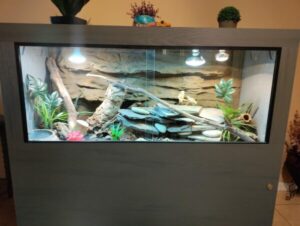
A naturalistic terrarium not only looks stunning but also mimics your reptile’s wild environment, keeping them happier and healthier.
Start With the Right Enclosure
Choose a terrarium based on your reptile’s species. Arboreal species (like chameleons) need tall enclosures, while ground dwellers (like leopard geckos or skinks) thrive in wide tanks.
Substrate Selection
Pick a substrate that suits your reptile’s needs. Coconut fiber works well for tropical reptiles, while aspen or sand alternatives are better for desert species. Avoid substrates that cause impaction, like calcium sand.
Plants and Decor
Live or fake plants provide hiding spots and help maintain humidity. Add cork bark, branches, rocks, and other climbing elements for enrichment. Always sanitize items you find outside before using them.
Lighting and Temperature
Use a reliable UVB light and basking bulb. Reptiles need a thermal gradient — a warm side and a cool side — to regulate their body temperature.
Humidity Control
Maintain proper humidity by misting, using water features, or adding moisture-retaining substrates. Install a hygrometer to track levels.
A naturalistic terrarium enhances both your reptile’s health and your enjoyment. Check out Sublime Reptiles for Sale for quality reptiles and setup advice.
